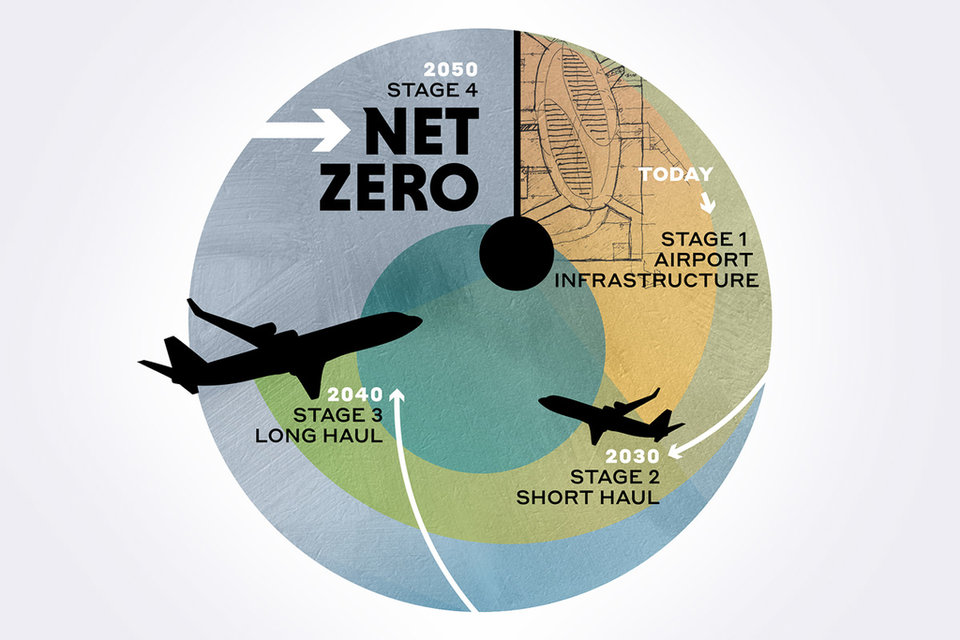Comment
Flying towards net zero
Woods Bagot aviation leader Richard Spencer and senior interior design leader Katy Mercer discuss how the aviation industry can meet its net zero goals without sacrificing passenger experience.
Without a doubt, 2020 has been a challenging year for the aviation sector, with global passenger air traffic dropping by 60.9% due to the coronavirus outbreak. Despite this setback, the aviation sector was growing strongly before the pandemic and is expected to continue to resume growth in the coming years.
Travel is a vital part of modern life and while many have accepted the temporary need to suspend the pursuit, there is also the desire to resume pre-Covid travel patterns in many parts of the globe. The most recent estimates had suggested that demand for air transport would increase by an average of 4.3% per annum over the next 20 years.
Sustaining this growth while meeting sustainability commitments and maintaining a high quality of passenger experience is a significant challenge for the aviation sector. Here, Woods Bagot aviation leader Richard Spencer and senior interior design leader Katy Mercer discuss whether the ambitious goal of net zero is possible how it could impact the passenger experience.

Richard Spencer, aviation leader at Woods Bagot

Katy Mercer, senior interior design leader at Woods Bagot
The UK aviation sector, along with major European aviation hub operators, has committed to being net zero by 2050. If 100 million extra passengers are added into the air each year, can the aviation industry really go net zero by 2050?
Richard Spencer: There are good intentions out there and a serious commitment about meeting those goals as a result – but getting to carbon neutral by 2050 is completely missing the boat. If we wait that long, we’re in deep trouble.
We need to do what we can with what we have, right now. It’s not about planning for 2050, it’s about aiming for as soon as viably possible. People my age can say, ‘Well, I don’t really care because by 2050 I won’t be around’, but it’s not us we should be thinking about – it’s future generations.
The roadmap to net zero can be thought about in three parts: Long haul, short haul and airport infrastructure. The good news is that if we start on the ground and look at airport infrastructure first, we can achieve net zero now. In fact, some airports have already achieved the kind of carbon neutrality we’re aiming for via the use of electric ground vehicles, lowered energy consumptions, solar panels and off-airport renewable energy sources.
Katy Mercer: Buildings can be designed to perform more efficiently from an energy consumption perspective. For example, San Francisco Airport’s Harvey Milk Terminal 1 is net-zero ready. So is our design for MSC South, a concourse at LA International Airport, and our design for Seattle-Tacoma International Airport’s C1 building. Luleå, Ronneby and Visby airports in Sweden have already achieved net zero, and over fifty airports in Europe have achieved Level 3+ Airport Carbon Accreditation.
Richard Spencer: It’s in the air that we have more work to do. I am optimistic that carbon neutral short-haul flights will be possible in 10 to 15 years’ time given current developments in electric planes and hydrogen fuel. Long haul is where the real challenge lies, and really where industry efforts could be more focused. Perhaps this is where offsets should be focused, and where we should look to curtail traffic growth to keep within a sustainable carbon budget.
Katy Mercer: It takes more than saying you’ll do something to get it done. For example, airport operators need to commit to using electric vehicles over just installing electric chargers, and research into synthetic and sustainable jet fuel needs to be supported in order to make a more significant difference. Airports and airlines need to commit to implementing these sustainable technologies as fast as they appear – we don’t want innovation to fall at the hurdle of implementation.
Richard Spencer: If we have a commitment to implementation guaranteed by the aviation sector and government, then we firm up the timeline to net zero. There are already electric plane prototypes being flown, and Airbus has an alternative fuelled net-zero aircraft that could carry out shorter flights. The hardest task – solving the puzzle of sustainable long-haul flying – requires the most time and attention.

This infographic from Woods Bagot illustrates the aviation sector’s journey towards net zero.
How can a growing industry plan to reduce its annual footprint from just over 36 million tonnes of CO2 globally to net zero in three decades?
Richard Spencer: Necessity breeds invention. It will take a great deal of innovation from multiple sectors to get off. But we have to be positive about what we can achieve to have any hope of success.
For the architecture and design industry, this means ensuring that the infrastructure at airports supports our sustainability goals. For example, 330 airports around the world have joined the Airport Carbon Accreditation programme, working first towards carbon neutrality and then to net zero.
Every airport project Woods Bagot has worked on in North America has had being either net zero or net-zero ready as a future goal. Dallas Fort Worth Airport, the world’s busiest airport through much of the pandemic, is committed to a net zero 2030 vision. So, there are signs of healthy progress on the ground.
Speaking more widely, the industry needs to look at using, and supporting the development of, more efficient planes and synthetic and sustainable jet fuel. Flight paths can also be reassessed for fuel savings.
Katy Mercer: It’s also about reframing travel so that passengers are more inclined to make sustainable choices. Simple steps like the regulation of unnecessary food waste via a requirement for passengers to ‘opt in’ to having a meal during a flight offers the freedom to decide against consuming what isn’t necessary.
Similarly, moving from gas cooking to all-electric will spare the consumption of natural gas at airports – making quite the impact when we consider they cater for around 25,000 people five times a day. At San Francisco, we ensured the installation of taps for refillable water bottles and opportunities to say no to packaging in food and retail, while visible composting stations provide welcome reminders and easy outlets to act with sustainability in mind.
It’s important to remember how beautiful these spaces are. The idea that sustainability is the enemy of comfort or abundance is a myth.
Should the aviation industry be doing more, and could it do a better job of communicating its green strategies?
Katy Mercer: Everyone, from a single passenger to the biggest business conglomerate, needs to do more. The aviation industry can address its impact by demonstrating its accountability and becoming more transparent in its efforts, to keep our carbon offset goals at front of mind.
There needs to be visible and measurable evidence of the steps we’re taking to minimise negative environmental impacts. Travellers should be able to know the exact impact their trip makes on the environment. At the point of purchase there could be a carbon calculator that processes their choices and lets consumers see their carbon footprint. Passengers can only make better choices once they see the data.
Richard Spencer: The biggest lever we have to encourage change in the airline industry is money. The taxation of aviation fuel globally will curb unnecessary travel. If airlines charged the real cost – perhaps with an added detail of increasing tax according to how many flights taken in a year – perhaps travellers would find alternate ways of traveling. Consumers could be given a clearer means of choosing between saving the planet and air travel at some level.

The Harvey Milk Terminal at San Francisco International Airport. Credit: Joe Fletcher
Should designers aim to create the highest standard of passenger experience as a sustainable one? Are future travellers demanding this of the industry?
Katy Mercer: Absolutely. The demand from younger generations for services that reflect their values is growing. From my perspective as a designer, passenger experience can go hand-in-hand with a commitment to sustainability. A great passenger experience is one that supports what travellers care about, so an airport that facilitates the aim of a carbon neutral future is the best kind for designers to build, airlines to commission, and passengers to use.
Richard Spencer: The future of travel requires transparency and accountability. It’s expected that many travellers will choose rail when they can, with airports like Paris Airport going as far as signing a non-compete agreement with train operators.
We know that construction is a huge contributor to carbon emission. As a result, designers need to ensure airports are sustainable throughout their lifetime, even once they outlive their use. Biodegradable materials, modular elements that can be repurposed and more will all make a big impact. None of these measures should have any negative impact on the passenger experience.
Katy Mercer: The future sustainable airport is seamless, frictionless, organic and local. App-based technology will allow you to check in at home, have your luggage collected from your door and meet you at the hotel. ‘Localness’ will be ramped up; supporting local businesses, showcasing local materials, and designing with a sense of place are all to be expected.
What are some of the greatest challenges that the sector faces and what are some of the greatest opportunities?
Richard Spencer: The challenge lies in the disconnection between the excitement of growth – we put 100 million extra passengers through our airports in 2019 – and our responsibility to protect the planet.
A silver lining of the Covid-19 pandemic’s halt on international travel is older aircraft that were not fuel efficient being retired. Many airports have been able to make upgrades that reduce their carbon impact.
As the world speeds back into gear, it’s important that we don’t put a good crisis to waste. I’m a firm believer in the value of international air travel in terms of connecting us as citizens of the world and promoting cooperation globally, but we should have a carbon budget, and we ought to decide what is an appropriate allocation of carbon budget to long-haul international travel.
Main image: The Harvey Milk Terminal at San Francisco International Airport. Credit: Joe Fletcher